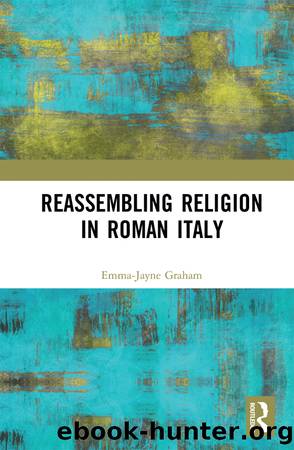Reassembling Religion in Roman Italy by Emma-Jayne Graham;

Author:Emma-Jayne Graham;
Language: eng
Format: epub
Publisher: Taylor & Francis (Unlimited)
Published: 2020-08-30T00:00:00+00:00
From individual to communal bodies
Even if the activities performed as part of a ritual act of dedication were largely prescribed by distal religious knowledge concerning its do ut des nature, and despite the fact that the mould-made origin of the objects discussed here caused some of them to be almost identical in physical form, when ritualised behaviour obliged them to combine with the material bodies, memories, sensory capacities, expectations, hopes, and physical movements of individual human dedicants, votive cult practices produced a spectrum of lived experiences of religious agency. In turn, these constructed subtly nuanced proximal forms of knowledge concerning an individualâs body and their place in a complex world comprising mortals, gods, and other things. Nevertheless, the knowledge produced by these experiences was also rationalised in relation to existing understandings of how this religious world worked and how to maintain it. Distal forms of knowledge were, after all, necessary for structuring the performance of these ritualised activities and for bringing people to a location which exhibited traces of similar activities enacted by other members of their community. Much as votive cult was performed and thereby lived on an individual level, it might also be closely entwined with the production of shared communal forms of religious knowledge too.
At Pantanacci, it appears that dedicants interacted with and rearranged previously dedicated offerings. Items were sometimes âstackedâ (e.g. a mask inserted into the concave section of a swaddled baby), and the excavators suggested that the niches and cavities into which they were inserted were selected in order to facilitate a sort of grouping together of similar types of object (Attenni and Ghini 2014, p. 156). There was certainly an inclination towards augmenting or otherwise altering the material qualities of offerings of all types in order to make them into something other than they were before they were dedicated. This includes filling or covering ceramic vessels with clay and actively encouraging spring water to continually wash over some of the miniature ceramic vessels. From the early published data about the site it is not clear when these interventions took place, but it is probable that it was part of the act of dedication itself â although, of course, the stacking of anatomical votives would only have been possible if there was already an item to add to or âenhanceâ, unless we are to imagine offerings of very different type being made at the same time by the same person. In effect, these equally religiously ritualised actions created new and unique things as well as new assemblages of things, assemblages that extended beyond the personal one-to-one of anatomical body part and its respective living counterpart to combine multiple more-than-human and human things into new configurations.
The augmentation of one type of body or body part with another provides an interesting contrast to attempts evident from elsewhere in the cave to segregate different types of model by grouping them together, suggesting that there were a number of potential actions available to the community who worshipped there, as well as different interpretations of what was appropriate for particular circumstances.
Download
This site does not store any files on its server. We only index and link to content provided by other sites. Please contact the content providers to delete copyright contents if any and email us, we'll remove relevant links or contents immediately.
| Africa | Americas |
| Arctic & Antarctica | Asia |
| Australia & Oceania | Europe |
| Middle East | Russia |
| United States | World |
| Ancient Civilizations | Military |
| Historical Study & Educational Resources |
Magic and Divination in Early Islam by Emilie Savage-Smith;(1499)
Ambition and Desire: The Dangerous Life of Josephine Bonaparte by Kate Williams(1344)
Bohemians, Bootleggers, Flappers, and Swells: The Best of Early Vanity Fair by Bohemians Bootleggers Flappers & Swells- The Best of Early Vanity Fair (epub)(1341)
Papillon by Henry Charrière(1309)
Twelve Caesars by Mary Beard(1256)
Operation Vengeance: The Astonishing Aerial Ambush That Changed World War II by Dan Hampton(1134)
What Really Happened: The Death of Hitler by Robert J. Hutchinson(1128)
London in the Twentieth Century by Jerry White(1111)
Time of the Magicians by Wolfram Eilenberger(1087)
The Japanese by Christopher Harding(1086)
Twilight of the Gods by Ian W. Toll(1084)
Lenin: A Biography by Robert Service(1043)
The Devil You Know by Charles M. Blow(985)
A Social History of the Media by Peter Burke & Peter Burke(936)
Freemasons for Dummies by Hodapp Christopher;(922)
Napolean Hill Collection by Napoleon Hill(902)
Henry III by David Carpenter;(890)
The Churchill Complex by Ian Buruma(879)
The Rise and Triumph of the Modern Self by Unknown(877)
